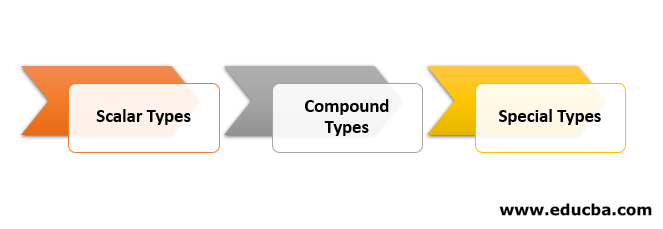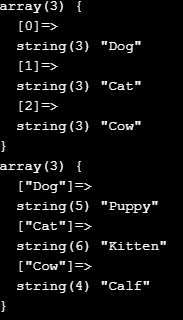PHP 資料類型
PHP 或超文本預處理器是一種基於 Web 的應用程式開發程式語言,可在其中合併 HTML 編碼以建立 Web 應用程式。在 PHP 中,有八種不同的資料類型用於在腳本中聲明和呼叫變數。它們是用於真或假值的“布林”,用於數字值的“整數”,用於十進制數字的“浮點/雙精度”,用於字元的“字串”,用於固定元素大小的“數組”,用於表示類別實例的“物件” ,'NULL' 表示void,'resources' 表示PHP 腳本外部的元素。
開始您的免費軟體開發課程
網頁開發、程式語言、軟體測試及其他
前 3 種 PHP 資料型別
用於儲存值的 PHP 變數可能與各種資料類型相關聯,從最簡單的 int 到更複雜的資料類型(例如陣列)。 PHP 被稱為鬆散類型程式語言,這意味著變數資料類型是在運行時根據其屬性決定的,並且沒有明確定義。它分析給定值的屬性,然後確定分配給它的資料類型。 PHP 支援 8 種原始資料類型,可進一步分為以下 3 種:
讓我們透過範例詳細了解每一個。

1.標量類型
它們可以進一步分為以下原始類型:
a.布爾
這些類型的可能輸出為 0 或 1,即 true 或 false。它們用於條件測試案例,其中滿足條件時事件傳回 true,不滿足時事件傳回 false。它還將 NULL 和空字串視為 false。
代碼:
<?php // TRUE is assigned to a variable value $variable_value = true; var_dump($variable_value); ?>
輸出:

b.整數
整數資料型別保存 -2,147,483,648 和 2,147,483,647 之間的非十進位整數值。此最大值和最小值取決於系統,無論是 32 位元還是 64 位元。透過使用常數 PHP_INT_MAX,我們可以找出最大值。它還保存以 10 為基數、以 8 為基數和以 6 為基數的值。
代碼:
<?php // example for decimal (base 10) $dec1 = 100; $dec2 = 200; // example for decimal (base 8) $oct1 = 10; // example for decimal (base 6) $hex1 = 0x15; $addn = $dec1 + $dec2; echo $addn; ?>
輸出:

c.浮動/雙
具有小數點或指數的數字稱為浮點數/實數。它可以有正數和負數。該數字應顯示預先定義的小數位數。
代碼:
<?php $dec1 = 0.134; var_dump($dec1); $exp1 = 23.3e2; var_dump($exp1); $exp2 = 6E-9; var_dump($exp2); ?>
輸出:

d.字串
字串資料型態基本上就是字元的集合,包括數字、字母和字母。它們可以保存高達 2GB 的值。如果必須在字串中顯示變量,則應使用雙引號聲明它們。另外,單引號也可以。
代碼:
<?php $name = "Jay"; $str1 = 'Declaring name in single quote as $name'; echo $str1; echo "\n"; $str2 = "Declaring name in double quote as $name"; echo $str2; echo "\n"; $str3 = 'Just a string'; echo $str3; ?>
輸出:

2.複合型
這些是無法指派新值的。數組和物件都屬於這一類。
a.數組
它是一種資料結構,具有固定大小的具有相似資料類型的元素的集合。它也用於以有序映射的形式儲存已知數量的鍵值對。它可用於多種用途,如列表、雜湊表(映射實作)、集合、堆疊、字典、佇列等;多維數組也是可能的。
一個簡單的陣列範例如下:
代碼:
<?php
$animals = array("Dog", "Cat", "Cow");
var_dump($animals);
$animal_babies = array(
"Dog" => "Puppy",
"Cat" => "Kitten",
"Cow" => "Calf"
);
var_dump($animal_babies);
?>輸出:

b.對象
它允許儲存資料(稱為其屬性)並提供有關如何處理資料(稱為物件的方法)的資訊。物件充當類別的實例,該類別用作其他物件的模板。關鍵字“new”用於建立物件。
每個物件都繼承父類別的屬性和方法。它需要每個物件中有一個明確聲明和一個「類別」。
代碼:
<?php
// Declaring a class
class statement{
// properties
public $stmt = "Insert any string here";
// Declaring a method
function show_statement(){
return $this->stmt;
}
}
// Creation of new object
$msg = new statement;
var_dump($msg);
?>輸出:

3.特殊型
PHP 中有 2 種特殊的資料類型屬於此類,因為它們是唯一的。他們是:
a. NULL
In PHP, this special NULL is used for representing empty variables, i.e. the variable has no data in it, and NULL is the only possible value to it. If it has been set to unset() or if no value has been set to it, a variable assigned to the constant NULL becomes a NULL data type.
Here we are setting NULL directly to val1. For the val2 variable, we are assigning a string value first and then setting it as NULL. In both cases, the final value of variables is NULL.
Code:
<?php $val1 = NULL; var_dump($val1); echo "<br>"; $val2 = "Any string"; $val2 = NULL; var_dump($val2); ?>
Output:

b. Resources
A resource is not an actual data type, whereas it is a special variable that keeps a reference to a resource external to PHP. They hold special handlers for files and database connections that are open. Special functions usually create and use these resources.
To run this code, we must have the file.txt created in the system with reading permission given to it. It throws an error in case “handle” is not a resource. Also, make sure to connect to any existing database in your system.
Code:
<?php
// Open an existing file to read
$handle = fopen("file.txt", "r");
var_dump($handle);
echo "<br>";
// Connecting to MySQL database server with settings set to default
$db = mysql_connect("localhost", "root", "");
var_dump($db);
?>Apart from the above data types, we also have something called pseudo-types: the keywords in PHP document used to indicate the types or values that an argument can have. Some of them are:
- mixed: They allow a parameter to accept more than one type. Ex: gettype()
- number: With a number, a parameter can be afloat or an integer.
- void, callback, array|object are some of the other pseudo-types
Conclusion
Here we have covered almost all of the data types which are available in PHP. All of the above 8 primitive types are implicitly supported by PHP, and there is no need for the user to specify them manually. Arrays and objects can hold multiple values, whereas, for rest, all can hold only a single value (except NULL, which holds no value).
以上是PHP 資料類型的詳細內容。更多資訊請關注PHP中文網其他相關文章!

熱AI工具

Undresser.AI Undress
人工智慧驅動的應用程序,用於創建逼真的裸體照片

AI Clothes Remover
用於從照片中去除衣服的線上人工智慧工具。

Undress AI Tool
免費脫衣圖片

Clothoff.io
AI脫衣器

Video Face Swap
使用我們完全免費的人工智慧換臉工具,輕鬆在任何影片中換臉!

熱門文章

熱工具

記事本++7.3.1
好用且免費的程式碼編輯器

SublimeText3漢化版
中文版,非常好用

禪工作室 13.0.1
強大的PHP整合開發環境

Dreamweaver CS6
視覺化網頁開發工具

SublimeText3 Mac版
神級程式碼編輯軟體(SublimeText3)
 適用於 Ubuntu 和 Debian 的 PHP 8.4 安裝和升級指南
Dec 24, 2024 pm 04:42 PM
適用於 Ubuntu 和 Debian 的 PHP 8.4 安裝和升級指南
Dec 24, 2024 pm 04:42 PM
PHP 8.4 帶來了多項新功能、安全性改進和效能改進,同時棄用和刪除了大量功能。 本指南介紹如何在 Ubuntu、Debian 或其衍生版本上安裝 PHP 8.4 或升級到 PHP 8.4
 在PHP API中說明JSON Web令牌(JWT)及其用例。
Apr 05, 2025 am 12:04 AM
在PHP API中說明JSON Web令牌(JWT)及其用例。
Apr 05, 2025 am 12:04 AM
JWT是一種基於JSON的開放標準,用於在各方之間安全地傳輸信息,主要用於身份驗證和信息交換。 1.JWT由Header、Payload和Signature三部分組成。 2.JWT的工作原理包括生成JWT、驗證JWT和解析Payload三個步驟。 3.在PHP中使用JWT進行身份驗證時,可以生成和驗證JWT,並在高級用法中包含用戶角色和權限信息。 4.常見錯誤包括簽名驗證失敗、令牌過期和Payload過大,調試技巧包括使用調試工具和日誌記錄。 5.性能優化和最佳實踐包括使用合適的簽名算法、合理設置有效期、
 您如何在PHP中解析和處理HTML/XML?
Feb 07, 2025 am 11:57 AM
您如何在PHP中解析和處理HTML/XML?
Feb 07, 2025 am 11:57 AM
本教程演示瞭如何使用PHP有效地處理XML文檔。 XML(可擴展的標記語言)是一種用於人類可讀性和機器解析的多功能文本標記語言。它通常用於數據存儲
 解釋PHP中的晚期靜態綁定(靜態::)。
Apr 03, 2025 am 12:04 AM
解釋PHP中的晚期靜態綁定(靜態::)。
Apr 03, 2025 am 12:04 AM
靜態綁定(static::)在PHP中實現晚期靜態綁定(LSB),允許在靜態上下文中引用調用類而非定義類。 1)解析過程在運行時進行,2)在繼承關係中向上查找調用類,3)可能帶來性能開銷。
 php程序在字符串中計數元音
Feb 07, 2025 pm 12:12 PM
php程序在字符串中計數元音
Feb 07, 2025 pm 12:12 PM
字符串是由字符組成的序列,包括字母、數字和符號。本教程將學習如何使用不同的方法在PHP中計算給定字符串中元音的數量。英語中的元音是a、e、i、o、u,它們可以是大寫或小寫。 什麼是元音? 元音是代表特定語音的字母字符。英語中共有五個元音,包括大寫和小寫: a, e, i, o, u 示例 1 輸入:字符串 = "Tutorialspoint" 輸出:6 解釋 字符串 "Tutorialspoint" 中的元音是 u、o、i、a、o、i。總共有 6 個元
 什麼是PHP魔術方法(__ -construct,__destruct,__call,__get,__ set等)並提供用例?
Apr 03, 2025 am 12:03 AM
什麼是PHP魔術方法(__ -construct,__destruct,__call,__get,__ set等)並提供用例?
Apr 03, 2025 am 12:03 AM
PHP的魔法方法有哪些? PHP的魔法方法包括:1.\_\_construct,用於初始化對象;2.\_\_destruct,用於清理資源;3.\_\_call,處理不存在的方法調用;4.\_\_get,實現動態屬性訪問;5.\_\_set,實現動態屬性設置。這些方法在特定情況下自動調用,提升代碼的靈活性和效率。
 PHP和Python:比較兩種流行的編程語言
Apr 14, 2025 am 12:13 AM
PHP和Python:比較兩種流行的編程語言
Apr 14, 2025 am 12:13 AM
PHP和Python各有優勢,選擇依據項目需求。 1.PHP適合web開發,尤其快速開發和維護網站。 2.Python適用於數據科學、機器學習和人工智能,語法簡潔,適合初學者。
 PHP:網絡開發的關鍵語言
Apr 13, 2025 am 12:08 AM
PHP:網絡開發的關鍵語言
Apr 13, 2025 am 12:08 AM
PHP是一種廣泛應用於服務器端的腳本語言,特別適合web開發。 1.PHP可以嵌入HTML,處理HTTP請求和響應,支持多種數據庫。 2.PHP用於生成動態網頁內容,處理表單數據,訪問數據庫等,具有強大的社區支持和開源資源。 3.PHP是解釋型語言,執行過程包括詞法分析、語法分析、編譯和執行。 4.PHP可以與MySQL結合用於用戶註冊系統等高級應用。 5.調試PHP時,可使用error_reporting()和var_dump()等函數。 6.優化PHP代碼可通過緩存機制、優化數據庫查詢和使用內置函數。 7






